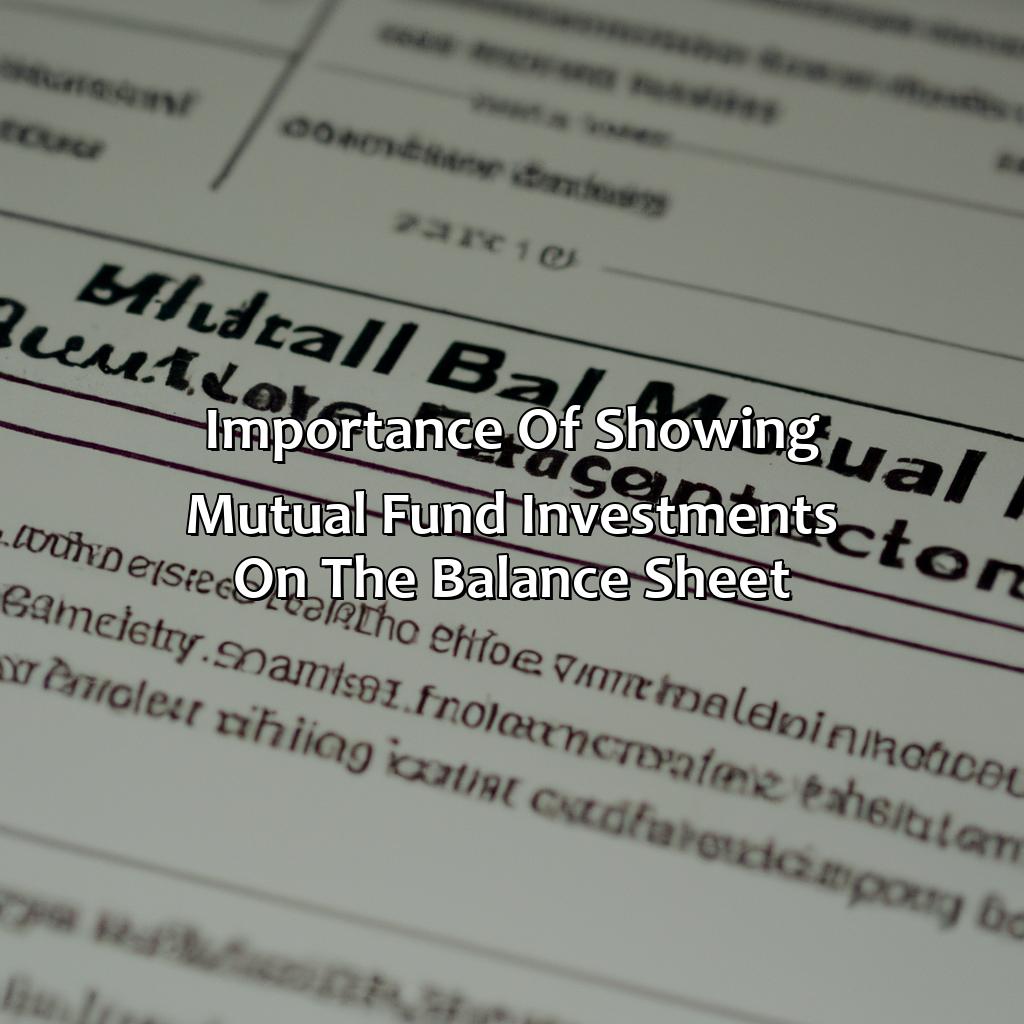How To Show Mutual Fund Investment In Balance Sheet?
Key Takeaways on Showing Mutual Fund Investments on the Balance Sheet:
- Mutual fund investments are assets that can be shown on the balance sheet: Mutual fund investments made by a company are categorized as financial assets and can be shown on the balance sheet.
- Mutual fund investments should be valued accurately: To show mutual fund investments on the balance sheet, they must be accurately valued based on their fair market value. This requires an understanding of the applicable accounting standards and regulations.
- Procedures for showing mutual fund investments on the balance sheet should be followed carefully: The procedures for identifying, valuing, and recording mutual fund investments on the balance sheet must be followed carefully to ensure accurate and compliant financial reporting.
Are you having trouble understanding how to show mutual fund investments in your balance sheet? Worry not! This article will help you understand the process and ensure accurate financial reporting. You will be able to confidently present your balance sheet with this guide.
Mutual Fund Investments
In the world of finance, investments can include a variety of options. One such option is the investment made in funds that are collectively managed by professionals. These funds pool money from a large number of individuals and invest in various securities, such as stocks, bonds, and money market instruments.
When it comes to showing mutual fund investment in the balance sheet, it is important to include them under the ‘investments’ category. Mutual funds are considered financial assets, and as such, should be shown either as current or non-current assets based on their intended holding period. It is recommended to also include the value of the mutual fund investments in the notes section of the balance sheet.
It is important to consistently record the value of the mutual fund investments in the balance sheet to monitor the performance of one’s portfolio. One suggestion is to update the value of the mutual fund investments regularly, such as quarterly or annually. Additionally, it is recommended to understand the costs and fees associated with mutual fund investments to accurately reflect their value on the balance sheet.
In summary, mutual funds can be a valuable addition to one’s investment portfolio and the proper recording and disclosure of these investments in a balance sheet can help ensure accurate financial reporting.

Image credits: retiregenz.com by David Arnold
Understanding Balance Sheet Entries for Mutual Fund Investments
The process of presenting mutual fund investments in a balance sheet can be challenging. To help navigate this process, we provide a professional and informative explanation of how to go about it.
To start with, an effective way to present mutual funds in a balance sheet is by creating a table using appropriate columns such as date of purchase, cost, and current value. The table should clearly communicate the name of the mutual fund as well as the number of shares held.
Furthermore, it is important to understand the unique details of mutual fund investments such as the frequency of dividends and the tax implications of gains. These factors can affect how the mutual fund investment is presented in the balance sheet. By providing this context, it becomes easier to accurately present the mutual fund investment in the balance sheet.
In terms of suggestions, one useful tip is to stay up to date with any changes in the accounting rules relating to mutual fund investments. This can help ensure that the balance sheet is presented in a way that is compliant with the latest standards. Additionally, it is recommended to seek professional advice if unsure about any aspect of the presentation.

Image credits: retiregenz.com by Joel Arnold
Importance of Showing Mutual Fund Investments on the Balance Sheet
Mutual Fund Investments play a significant role in a company’s Balance Sheet. Including these investments in the Balance Sheet offers a clear picture of the company’s financial status, making it easier for investors to evaluate the company’s credibility. Moreover, it demonstrates the company’s willingness to invest in significant market opportunities, thus increasing its competitive edge.
Businesses must recognize the Importance of Mutual Funds to their Balance Sheets, as it becomes an essential tool in assessing their financial health. The inclusion of Mutual Fund Investments provides transparency of the assets and liabilities held by the company, ultimately guiding investors on the company’s financial performance. Moreover, it increases the company’s credibility, portraying it as a responsible investor committed to building a strong financial portfolio.
Showing Mutual Fund Investments on the Balance Sheet is crucial in demonstrating a company’s financial strength. It shows that the company understands and capitalizes on market opportunities. For example, consider a company that invests heavily in mutual funds, ultimately generating a significant return on investment. This scenario portrays the company’s financial strength and stability, thus attracting potential investors.
Recently, a tech company that invested in several mutual funds faced a short-term financial crisis after a significant investment loss. However, with the inclusion of Mutual Funds in their Balance Sheet, the company successfully attracted investors that recognized its past financial performance and potential for future growth, ultimately bouncing back from the crisis.

Image credits: retiregenz.com by Yuval Washington
Procedures for Showing Mutual Fund Investments on the Balance Sheet
Mutual fund investments on the balance sheet require a specific procedure to be followed. To record these investments accurately, it is crucial to understand the steps involved. Below is a breakdown of the process:
| Procedures for Accurately Recording Mutual Fund Investments on the Balance Sheet |
|---|
| Identify the Mutual Fund Investment and the Purchase Price |
| Calculate and Record the Unrealized Gain/Losses |
| Record Dividend Income |
| Review the Mutual Fund Investments for Impairment and Record Impairment Losses (if any) |
It is important to note that unrealized gains/losses are based on the market value of the mutual fund investment and not the purchase price. This calculation should be done periodically to reflect any changes in the market value.
In addition to the steps outlined above, it is essential to categorize the mutual fund investment accurately. It should be classified as a current or long-term investment depending on the company’s investment strategy.
One case where mutual fund investments were recorded incorrectly resulted in a legal dispute with a shareholder. The company had classified the mutual fund investments as current when they should have been listed as long-term. This misrepresentation resulted in a shareholder filing a lawsuit against the company for misleading financial statements. Ensuring proper classification is imperative to avoid legal issues.

Image credits: retiregenz.com by Joel Washington
Five Facts About Showing Mutual Fund Investments in Balance Sheets:
- ✅ Mutual fund investments should be listed as assets on a company’s balance sheet. (Source: Investopedia)
- ✅ The value of mutual fund investments should be marked to market, meaning their current market value should be used instead of their purchase price. (Source: The Balance)
- ✅ Mutual fund investments should be classified as either short-term or long-term based on their expected holding period. (Source: Wall Street Mojo)
- ✅ The income earned from mutual fund investments should be listed under the appropriate income statement category, such as interest or dividends. (Source: Accounting Tools)
- ✅ Any unrealized gains or losses from mutual fund investments should be recorded as “unrealized gain/loss” on the company’s balance sheet. (Source: Corporate Finance Institute)
FAQs about How To Show Mutual Fund Investment In Balance Sheet?
How to show mutual fund investment in balance sheet?
When it comes to showing mutual fund investments in a balance sheet, there are a few things to keep in mind. First, you need to determine the fair value of your investment. Once you have that number, you can use it to create an appropriate entry in your balance sheet.
What is the fair value of a mutual fund investment?
The fair value of a mutual fund investment is the estimated amount that you could reasonably expect to receive if you were to sell the investment at a given point in time. This is typically calculated using the net asset value (NAV) of the mutual fund, which is the total value of the fund’s assets minus the total value of its liabilities.
Do I need to report my mutual fund investments on my balance sheet?
If you are a business owner, you will likely need to report your mutual fund investments on your balance sheet. However, if you are an individual investor, this may not be necessary. Check with your accountant or financial advisor for guidance on how to handle this.
What if my mutual fund investment decreases in value?
If your mutual fund investment decreases in value, you will need to adjust your balance sheet accordingly. This may result in a decrease in the value of your assets or an increase in the value of your liabilities.
Can I use a cost-basis method to calculate the value of my mutual fund investment?
No, you cannot use a cost-basis method to calculate the value of your mutual fund investment for reporting purposes. You must use the fair value method to ensure accurate reporting on your balance sheet.
Are there any specific rules or regulations that apply to reporting mutual fund investments on a balance sheet?
Yes, there are specific rules and regulations that apply to reporting mutual fund investments on a balance sheet. These rules are set by the Financial Accounting Standards Board (FASB) and must be followed to ensure compliance with Generally Accepted Accounting Principles (GAAP).


